Coin collections have always drawn people’s attention, whether it’s for a hobby or to make money. Check out these valuable pennies and find out why they’re worth millions altogether.
1804 Silver Dollar Class I – $4.1 million
There are three different classes of the 1804 Silver Dollar, also known as the “King of Coins”, and the class I sold for about $4.1 million.

Although the coin is labelled 1804, none of the coins were minted during that time. It was done after the 1830s. The front displays Lady Liberty with “liberty” inscribed in it, and the back shows a golden eagle with 13 stars.
1922-D Lincoln, No D, Strong Reverse, Die Pair 2 – $63,000
This coin is officially 3.11 grams in weight and comprises copper, tin, and zinc. Like the last coin, this one is also missing the mint mark due to Denver Mint’s damaged die.

The fresh head die explains how this coin had a sharper image on the back than the obverse side. The Die Pair II was considered to be the “true” one among all of its versions. It was sold for $63,000 in Baltimore back in 2018.
1873 Doubled ‘Closed 3’ Indian Head Penny – $12,650
This Indian One cent penny was designed in two different patterns. Its specialty lies in the gap in the number ‘three’ in the year “1873.” If this gap is wide, it is considered as “Open 3.” If not, that would be a “Closed 3.”

Because of this dual appearance and being only one million in the circulation of its time, the “Closed 3” coin upheld a higher value than expected. This 3.11-gram coin, made of copper, tin, and zinc, was sold at $12,650.
1914-S Lincoln Penny – $105,800
This bronze coin has a diameter of 19 mm and weighs 3.11 grams. The higher percentage of copper gives it a bright red color that did not fade out due to reduced circulation and good preservation methods.

This penny, along with over four million others, was minted in San Francisco. It was in August 2006 when this penny was sold with its original red color. It was able to make $105,800 for previous owners Bowers and Merena.
1907 Golden Eagle Wire Edge – $2.8 million
Designed by Christian Gobrecht, the Ten Dollar Liberty Head Gold Eagle was minted between 1838 and 1907. The mintage remained for 69 years, making this one of the most used coins minted in the U.S history. The obverse shows an amazing rendition of Lady Liberty as she’s donning a Coronet with words “Liberty” inscribed on it.

The reverse side displays a triumphant heraldic eagle. With little of the final issues existing in graded mint state 64, the coin is extremely valuable. One coin was sold at a 2017 auction.
1793 Flowing Hair Liberty Cap Large Cent Penny – $19,950
This cent with a pretty Miss Liberty has multiple subtypes. The liberty cap cent was type III, issued in late 1793. The cap was to honor the revolutionary war in America.

The official weight was 13.48 grams, but it was reduced to about 11 grams later. This caused many of them to have plain edges, which became a rare characteristic in later years. This copper coin was sold on eBay for $19,950.
1922 Lincoln No D Strong Reverse and Weak Obverse Wheat Penny – $48,000
Of the three versions, this version of the coin is strongly distinguishable. It has quite sharp edges on the head side due to the fresh die where the obverse once had a blurry head.

It missed the mint mark, and the number of certified coins was even less than the actual number of coins made due to the refusal of attribution from NGC for more than 15 years. Who could imagine that this 3.11-gram bronze coin could make $48,000?
2007 C$1M Coin – $4.1 million
Here’s a coin where the price matches the size. The gigantic, 100 kg 2007 C$1M coin has been made out of 99.999% pure gold and remains one of the most symbolic coins to date.

The face value of it was actually just a million, but it sold for $4.1 million in an auction. It was specially minted by the Royal Canadian Mint for an occasion, so it’s understandable how the price inflated to that extent.
1969 S Lincoln Penny Doubled Die Obverse – $126,500
This penny made of copper and zinc weighs about 3.11 grams. It was minted in San Francisco. The reason behind the double image on this coin could be the improper preparation of the die. However, what makes this special is that, in 1970, people started to forge this doubled die coin to cash in.

Five coins were destroyed by the government to avoid the consequences. Later, an uncirculated, red-brown colored double die obverse penny was sold for $126,500 in January 2008.
1913 Liberty Head Nickel – $4.5 million
The 1913 Liberty Head Nickel is one of the most valuable coins in the entire world. The reason behind the shocking price tag is only five of these coins made it to the public and the rest were destroyed. There have been talks over the years indicating there might be a sixth one, but nothing has been confirmed yet.

The finest 1913 Liberty Nickel was valued at $5 million minimum, and it was sold at that price in 2007. In 2018, the club was resold at only $4,56,0004.
1933 Double Eagle – $7.6 million
Titled as the notorious coin of America, the 1933 Double Eagle is shipper valuable to any investor or collector, but owning it hasn’t been a breeze. For starters, it’s almost illicit to own it.

Secondly, the coin has been known to bring bad luck to the handful who got a hold of it. Another case of Condition Rarity is that these coins weren’t made to be circulated to the public but somehow, they were released. Only a few made it through the long years since then.
1944-D Lincoln Penny – $115,000
This penny is made of zinc-coated silver and weighs about 2.70 grams. It was mistakenly made by striking on a blank silver coin in 1943. However, copper planchets were used again from 1944.

There are records of the silver coins having both “S” and “D” mint marks, but the estimated number of Denver mints is no more than ten. Heritage Auctions sold an uncirculated coin in August 2007, and it was worth about $115,000.
1877 Indian Head Penny – $149,500
This Indian Head penny is the rarest of all in the series. As mentioned before, fully red Indian Head pennies are very hard to come by. In addition to that, only 852,500 coins were ever produced.

About ten million cents were returned due to economic depression, and 9,821,500 of them were reissued. Needless to say that this penny was one of the few to come this far. Its copper-red color remained the same when it was sold in August 2007 by Heritage Auctions for $149,500.
1926-S Lincoln Penny – $149,500
This 3.11-gram penny was minted in San Francisco. For an unknown reason, the mintage numbers were low that year. The details of the typical coins in 1926 were poor on both sides due to the heavily used dies. However, this particular penny exceptionally belongs to the few coins that were struck with fresh ones.

This one was found in excellent condition and was sold in January 2006 at Orlando. Heritage Auctions made $149,500 from this beautiful piece from their collection.
1864 Indian Head Penny With ‘L’ on the Ribbon – $161,000
Some time in the middle of 1864, the government switched from a copper-nickel mix to a bronze alloy, which led this coin to be composed of copper, tin, and zinc. They also added the letter “L” on the ribbon’s tail of Lady Liberty.

Among the five million of them, a very low number remained in uncirculated condition. This 3.11-gram coin was sold by Heritage Auctions at Pittsburgh in October 2011. Its value amounted to $161,000.
1914-D Lincoln Penny – $158,625
These pennies had to go through a lot. These have a record of poor survival rates due to a higher circulation rate. Those that survived are not likely to be in a good condition. Many of the collectors even faked these coins by altering the 1944 D Lincoln Pennies.

However, 1914 D cents have smaller mintmarks, and the gap between nine and four is easily noticeable. An uncirculated penny made $158,625 in May 2018. This 3.11-gram coin consists of copper, tin, and zinc.
1872 Indian Head Penny – $126,500
Another bronze coin weighing about 3.11 grams is this Indian Head Penny that was sold at Milwaukee in August 2007. This completely red coin is truly rare and is the lowest minted among the Indian Head series.

These coins are not only rare to find in the present time but are also only found in very poor conditions. However, this penny was from a fresh die and was found in an excellent and uncirculated condition. It made $126,500 for the Heritage Auctions.
1943 Bronze Lincoln Penny – $204,000
This 3.11-gram copper-red coin is an example of one of the most popular coin mistakes in history. It consists of copper, tin, and zinc. These pennies were mistakenly struck in bronze in 1943. In the year 1947, a high school student found this coin in his pocket change.

For the first time, this coin was sold in January 2019 by Heritage Auctions. However, some reports state that, in 2013, Stack Bowers Galleries made $164,500 from another one of these bronze coins.
1795 Reeded Edge Cent – $1.26 Million
One of the rarest or of all-important big cent varieties, the 1785 Reeded Edge suffers from Condition Rarity. There are only seven confirmed survivors, all of which are in low grade. The finest known is a VG10 coin graded by PCGS.
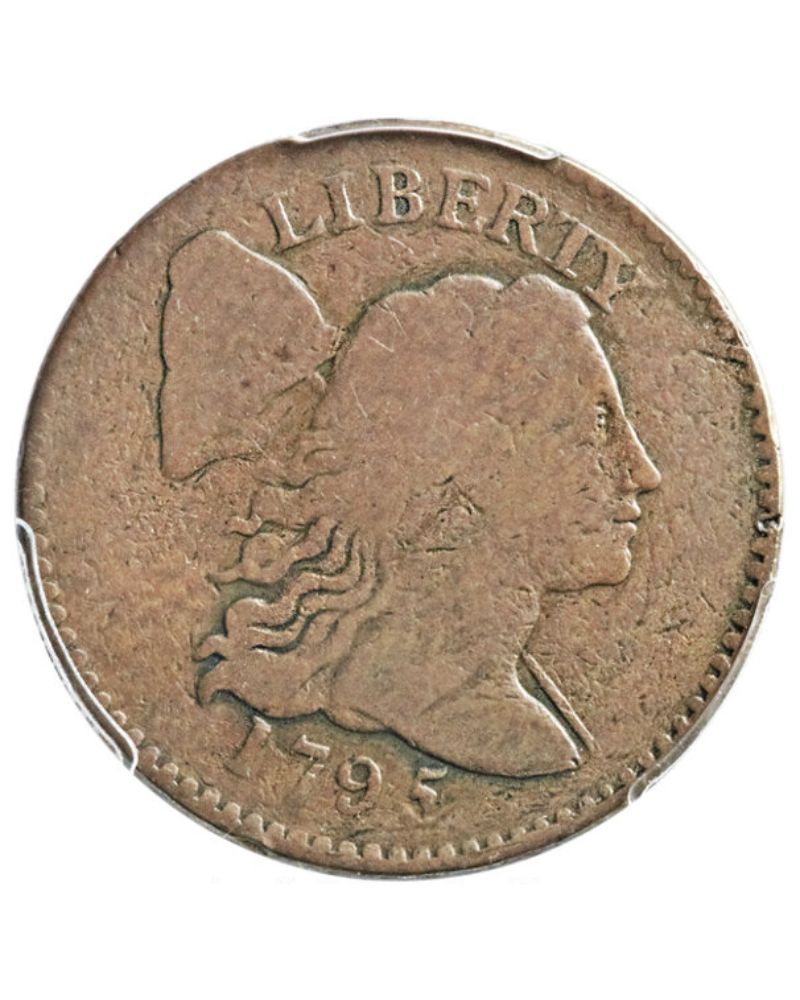
In 2008, this became the first large cent that had a selling price of a million dollars and beyond. These coins weren’t meant for the general public, they were more of the experimental kind, which explains why only seven are left.
1943-D Lincoln Bronze Penny – $1,700,000
Instead of zinc-plated silver, the 1943-D Lincoln Bronze coin was produced from a bronze alloy. This coin is the only identified reference of its type from the Denver Mint. However, around twenty coins consisting of the bronze alloy were found from each of the Mints in Philadelphia and San Francisco.
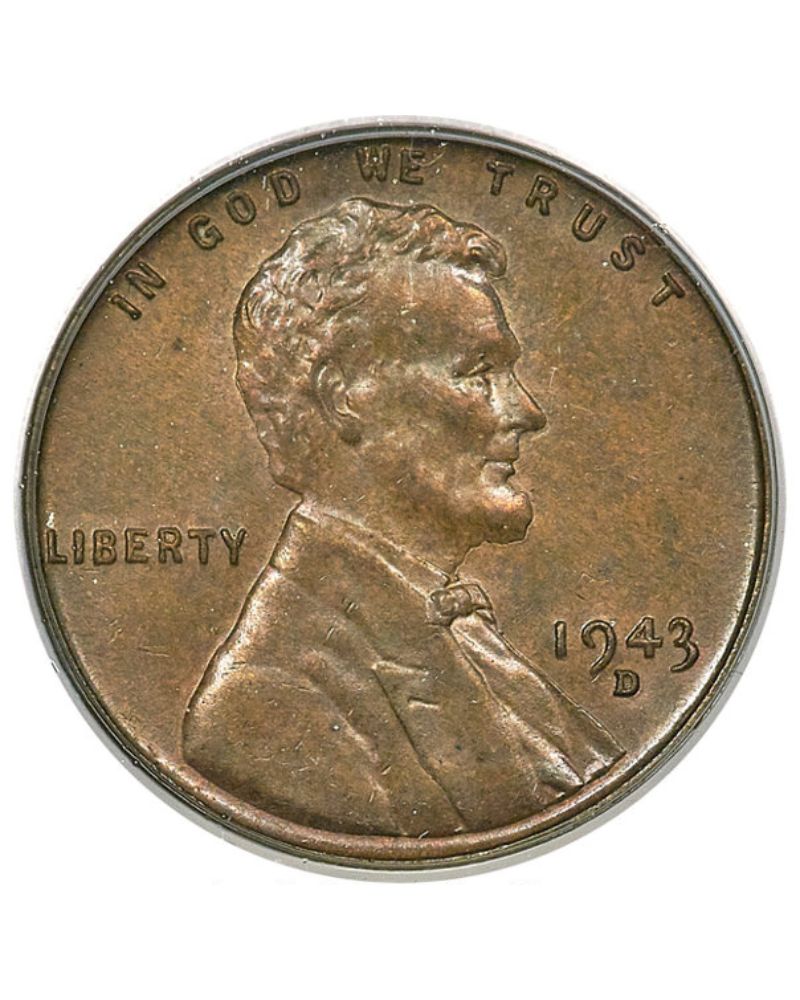
This Denver minted coin made from copper and tin weighs only 3.11 grams. It was in New Jersey in 2010 that it made $1,700,000 for Legend Numismatics in a private sale.
1856 Flying Eagle Penny – $172,500
This iconic 4.70-gram coin was made from a copper-nickel alloy. It was issued for a really short period of time. The government reduced the size in diameter and mixed copper with other materials in 1856 due to cost issues. Meanwhile, foreign gold and silver coins were also replaced by the Flying Eagle pennies.

Somehow, these coins were discontinued soon and replaced by the Indian Head pennies. Due to its design and rare existence, it drew the attention of many and was sold in 2004 for $172,500.
1909 V.D.B. Matte Proof Lincoln Penny – $258,500
These are the very first Lincoln pennies. At the bottom, the initials of the designer “V.D.B” were tagged although they were removed afterward. Unlike other pennies with initials, this one was struck with a matte proof die.

Before the removal of the initials, only 1,194 coins were produced in this way. This 3.11-gram coin made from copper, tin, and zinc was found in excellent condition and made $258,500 for Heritage Auctions in August 2014.
1343 Edward III Florin – $6.8 million
While some coins are old and some are older, this one is literally ancient. All the way back from 1343, Edward III Florin’s coins sell for that much of a price as only three of these are known to have survived for centuries.

The coin is called the “double leopard” and at the time of inception, it went for six shillings. The calculated present-day withstands at $6.8 million, the price it went for a few years ago in an auction.
1943 Bronze Lincoln Penny – $1 Million
This 3.11-gram penny was also mistakenly coined in bronze like the 1943-D Bronze Lincoln penny. As there was no mint mark engraved, this was minted from Philadelphia.
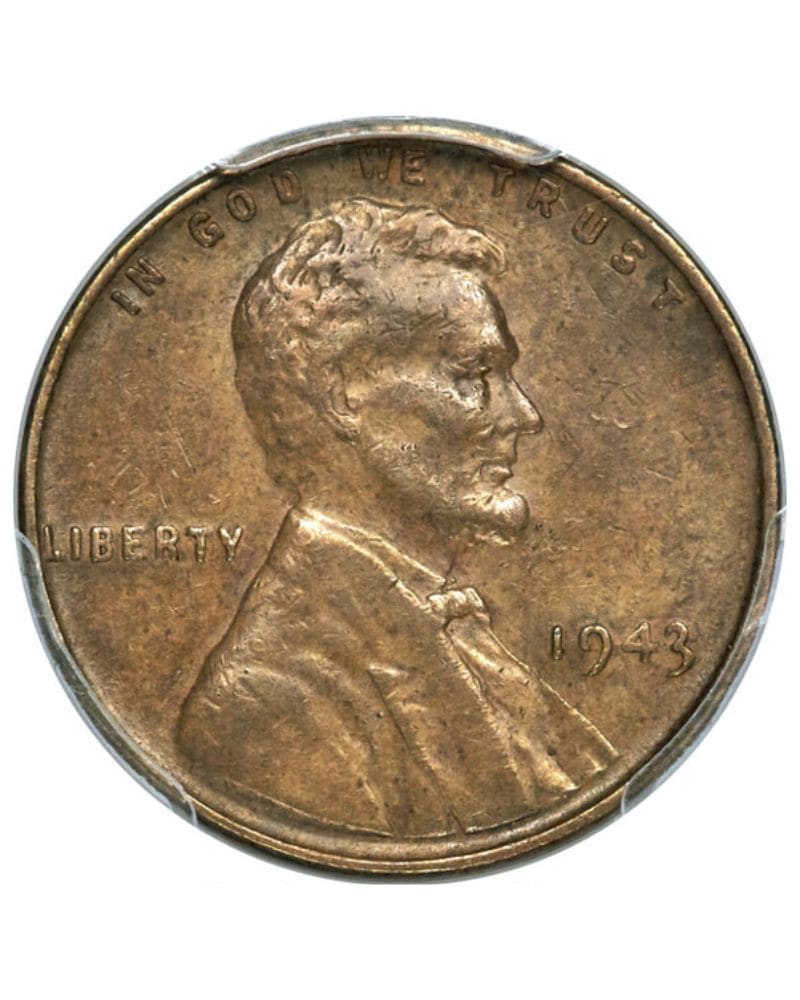
Sources report the existence of not more than a dozen Philadelphia 1943 bronze cents, of which two were recently certified. Besides, this is the only coin that is certified as a “red” penny from 1943, minted at Philadelphia. This coin was privately sold for $1 million in Florida in 2018.
1888 Indian Head Penny (Last 8 Over & Variety) – Up to $39,064 (Uncirculated Mint State)
This penny minted in the late 1800s has a unique feature that makes it valuable. Minted in 1888, it seems as if the year 1888 was printed above an existing 1887 year. The slightly visible number seven under the number eight is what gives this coin that extra special touch.

This coin was engraved by James B. Longacre at the Philadelphia, Pennsylvania mint. While coins in “good” condition can be worth a little over $1,300, coins in mint condition can reach almost $40,000!
1955 Doubled Die Obverse Lincoln Wheat Cent – $17,057+ (Uncirculated Mint State)
An engraving error in this 1955 penny means double the fun for coin collectors. This fairly modern coin is considered valuable because of an error that occurred during the minting process, which resulted in the phrase “IN GOD WE TRUST” and the word “LIBERTY” being duplicated.
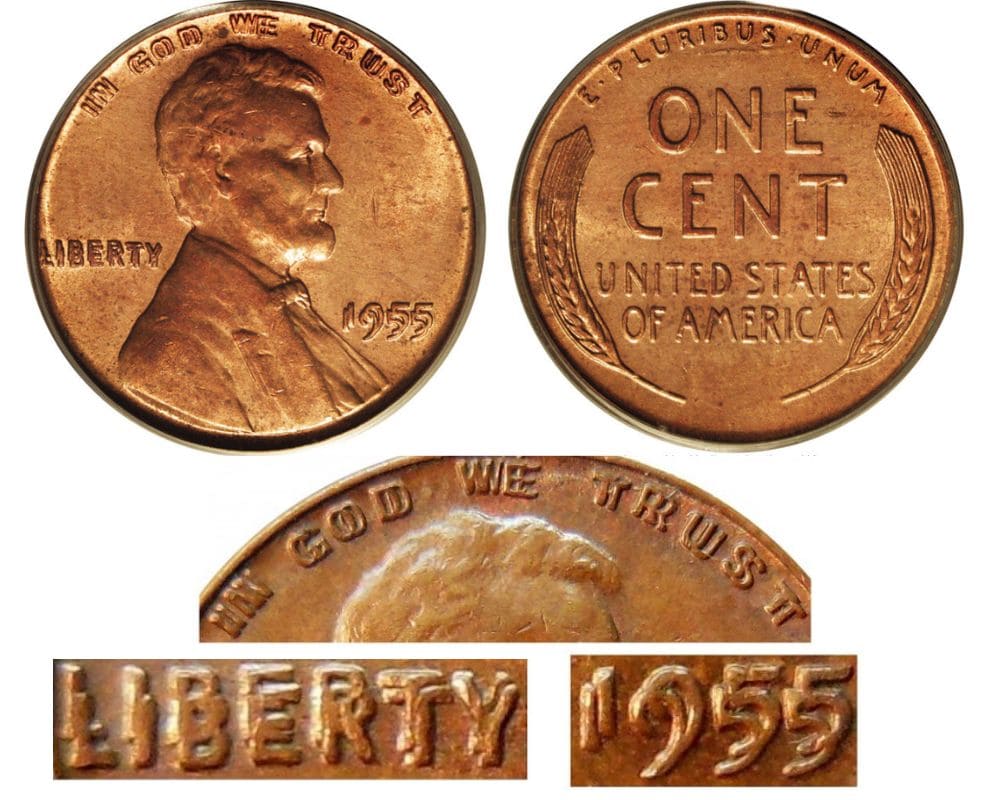
The year the coin was minted (1955) is also visibly duplicated. What was presumable once an embarrassing error has made this coin all the more valuable.
1917 Lincoln Wheat Cent (Doubled Die Obverse) – $6,504 (Uncirculated Mint State)
Produced at the Philidelphia, Pennsylvania mint, this 1917 coin has a slightly noticeable design flaw — one that makes it popular with collectors. Coin designs are pressed onto metal by a stamp known as a die.
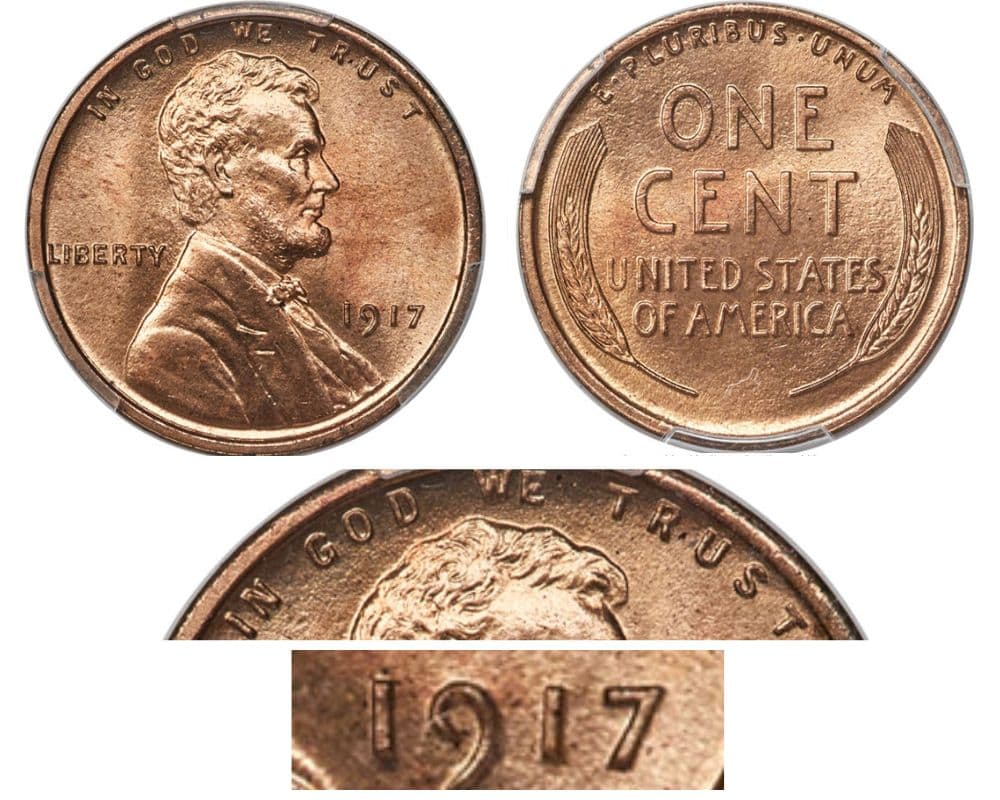
While these dies typically impart the design smoothly and accurately, there’s sometimes an overlap. In this 1917 penny, the motto “IN GOD WE TRUST” was stamped twice, as was the year 1917. Though this flaw is barely visible, it makes this coin very valuable.
1909 S Indian Head Cent – $1,318 (Uncirculated Mint State)
By the early 1900s, there was an increasing desire to revamp and redesign the penny. Many felt that the “Indian Head” design was outdated and they wanted a coin that would commemorate President Lincoln.
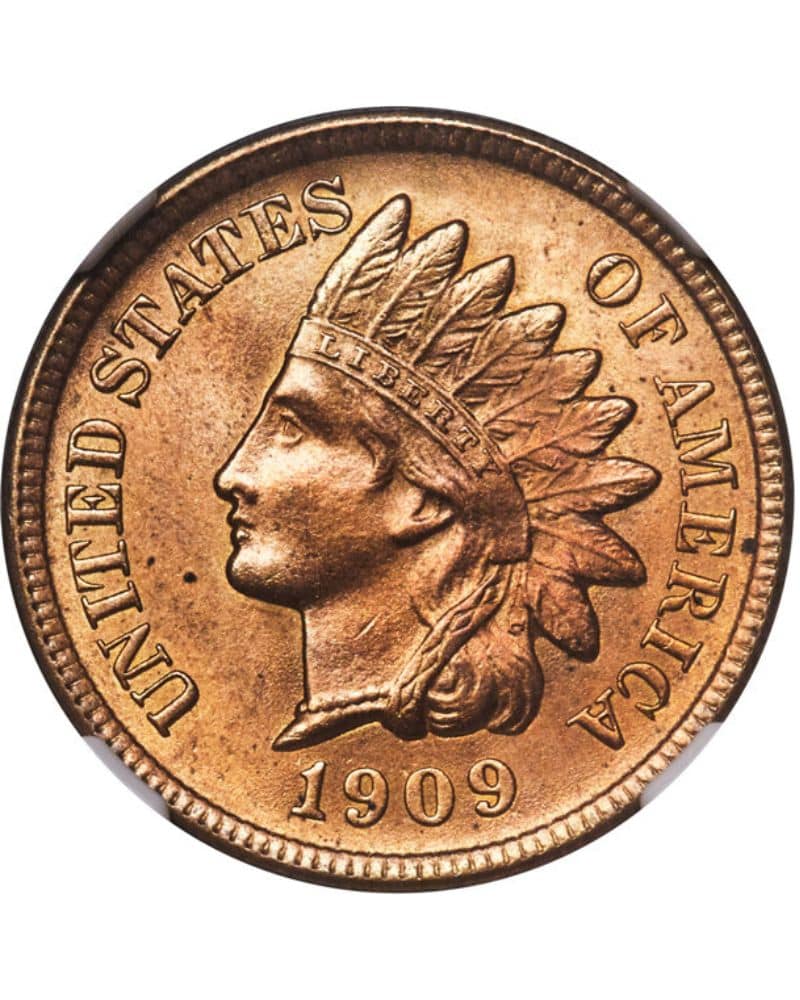
By early 1909, production of the Indian Head pennies dwindled and by late summer that year, the Lincoln cent had replaced the Indian Head. Because very few Indian Head pennies were minted that year, these 1909 coins are very precious to collectors.
S (Doubled Die Obverse) – $2,524 (Uncirculated Mint State)
Known as “Wheat Cents” for the two stalks of wheat featured on the back of the coin, the design of these pennies would be changed in 1959 to feature the Lincoln Memorial in Washington, D.C. instead.
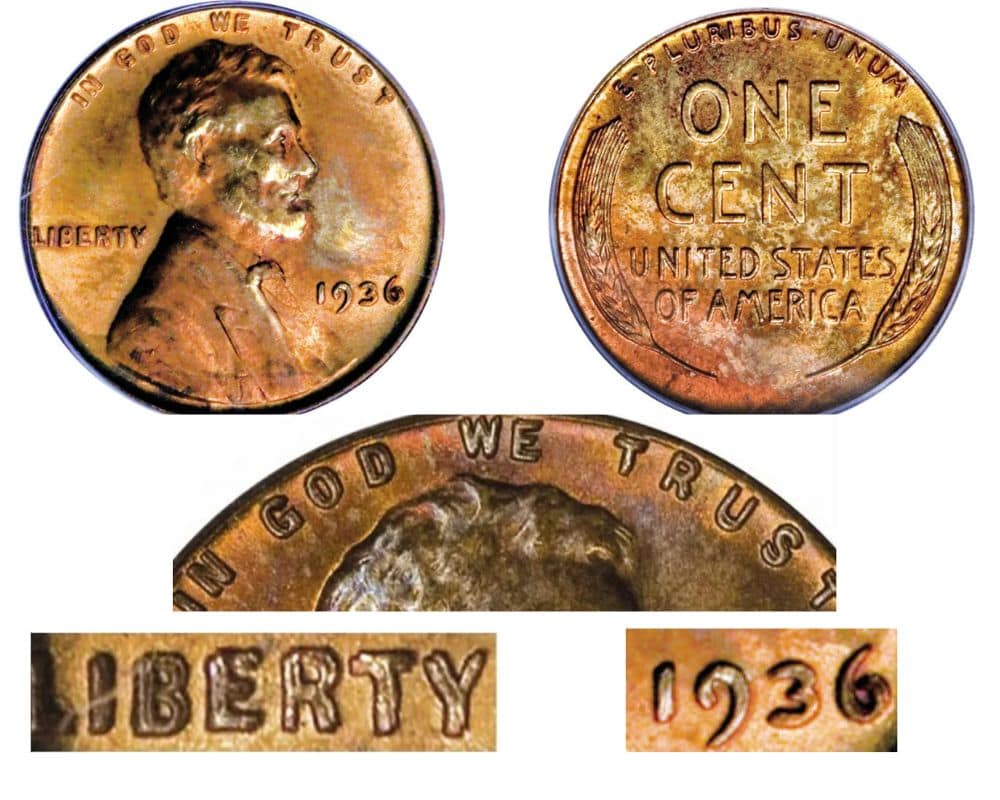
This 1936 Wheat Cent is valuable because of an engraving error that caused the motto “IN GOD WE TRUST” and the word “LIBERTY” to be stamped twice. Though this error isn’t quite noticeable, the duplication of the year 1936 is more obvious.
1858 Flying Eagle Cent Penny (8 Over 7 Variety) – $11,083 (Uncirculated Mint State)
While design flaws in most products are often a source of trouble, production flaws in coins seem to only enhance their value. The 1858 Flying Eagle Cent is a perfect example of how an engraving flaw can actually make a coin more precious to collectors.

The coin has two noticeable flaws. One flaw is that the year 1858 was printed above 1857 creating a noticeable overlap. Another design detail to look out for is the small “die chip” located above the year 1858.
1871 Indian Head Cent (Shallow “N”) – $1,082 (Uncirculated Mint State)
The Indian Head Cents printed in 1871 were created using an older and newer die. The older die, presumably less powerful, failed to create bold letters.
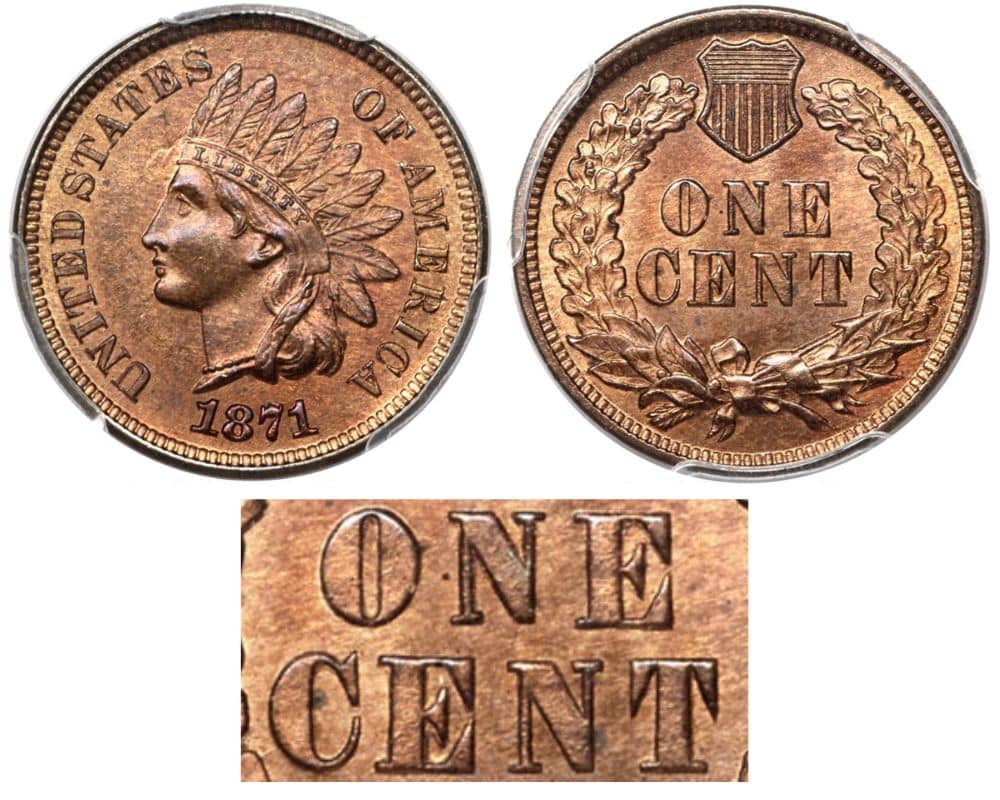
As a result, the letter “N” in the words “ONE CENT” on the back of the penny is considered to have been printed in a “shallow” way. Though the die was eventually replaced and the letters made bolder, collectors still value the “shallow” edition of these 1871 coins.
1894 Indian Head Cent (Double Date) – $1,268 (Uncirculated Mint State)
While double dates in real life aren’t always the most pleasant experiences, double dates on coins can mean more demand and higher value. This 1894 Indian Head Cent was one of a small number of coins minted with an engraving error — the number “94” was stamped twice.
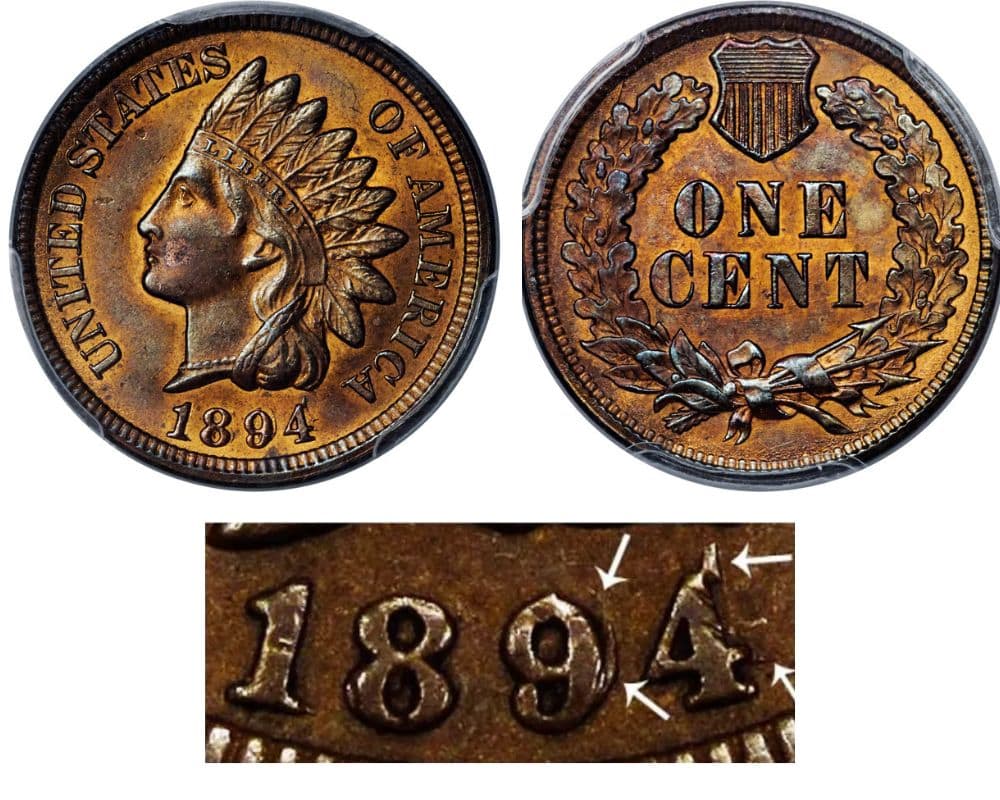
Repunched or duplicated dates often occurred during this period because the date on dies (stamps) was still being set by hand. Since not all coins minted that year have this error, coins with the doubled date are considered more valuable.
1869 Indian Head Cent (“9 Over 9” Variety) – $1,226 (Uncirculated Mint State)
Because the dates used on most dies were being placed by hand, there was a lot of room for error. One of the most common errors was the re-punching of dates into the metal.

While these duplicated numbers may be difficult to spot, collectors value these errors when it comes to appraising coins. This 1869 coin features a re-punching error in which the number “69” of the year 1869 was duplicated. Parts of the preexisting numbers can be visible under the date.
1826 Coronet Liberty Head Large Cent – $3,125 (Uncirculated Mint State)
It seems that some women just can’t seem to catch a break, even if they are the symbol of American liberty. In 1816, when master engraver Robert Scot unveiled his coin featuring goddess Liberty, the design was called, “ a spectacularly ugly head of Ms. Liberty.”

Though the woman featured on the coin underwent a radical makeover in 1836, this coin features Robert Scot’s original design. Coronet Liberty Head coins were eventually replaced by Flying Eagle coins in 1857.
1992 D Lincoln Memorial Cent (Close AM Variety) – $558+ (Uncirculated Mint State)
When most people think of valuable coins, they probably think of antique relics or treasure chests recovered from the bottom of the ocean. It turns out that there are some valuable pennies floating around that were minted after you were probably born!
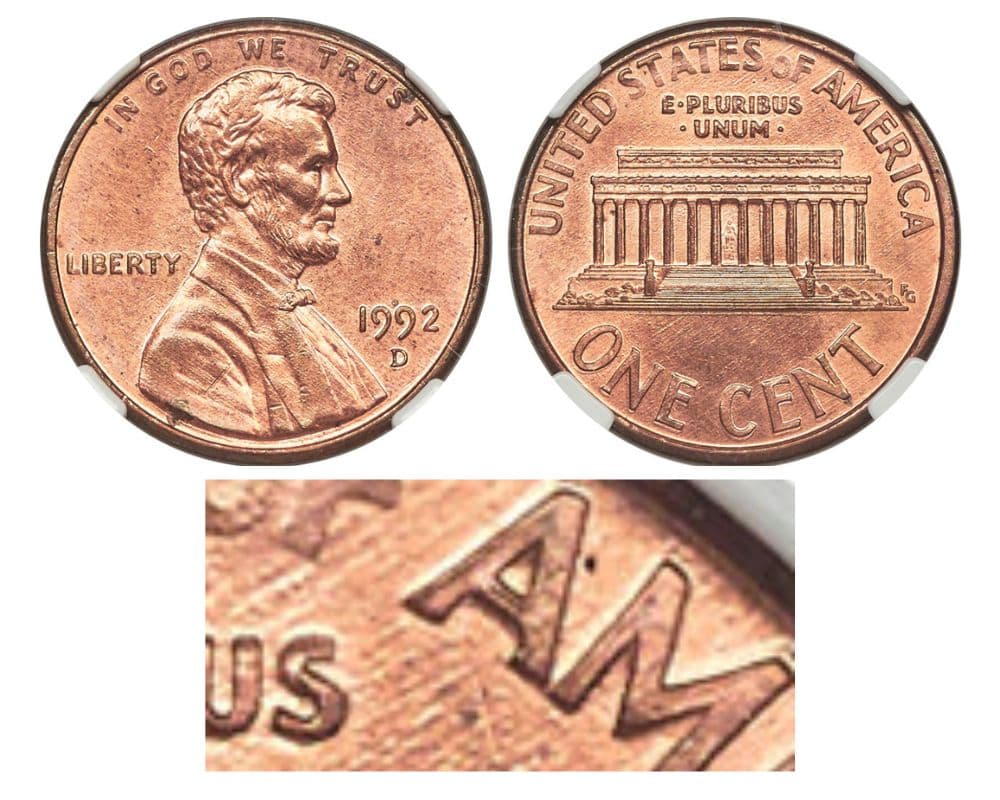
This penny — minted in 1992 in Denver, Colorado — features a design created by master coin engraver Frank Gasparro. The uniquely close distance between the letters “A” and “M” of America is what makes this modern coin so valuable.
1821 Coronet Liberty Head Large Cent – $12,535 (Uncirculated Mint State)
Coins of this period were often referred to as Matron Head cents due to Lady Liberty’s mature appearance. This coin features Lady Liberty wearing a headband with the word “LIBERTY” written across it.
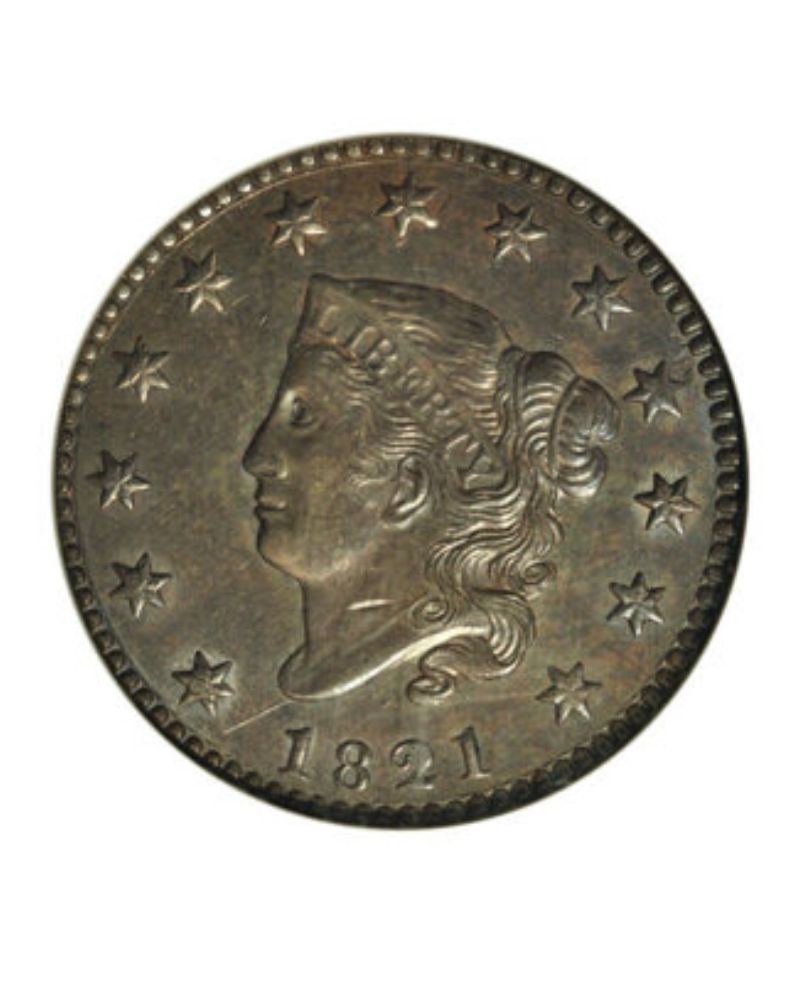
This coin, from 1821, is considered to be valuable because it features artist Robert Scot’s original design. With only 389,000 coins having been minted, it’s also considered to be quite rare and valuable to coin collectors.
1795 Cap Large Cent (Jefferson Head – Lettered Edge) – $285,279 (Very Fine Condition)
Like most collectibles, the rarer the item, the more valuable it is. Experts estimate that only three of these unique coins were minted. These coins, a variety of “Liberty Cap” coins, are the source of much debate between numismatists who argue that the coin wasn’t even created at the Philadelphia mint.
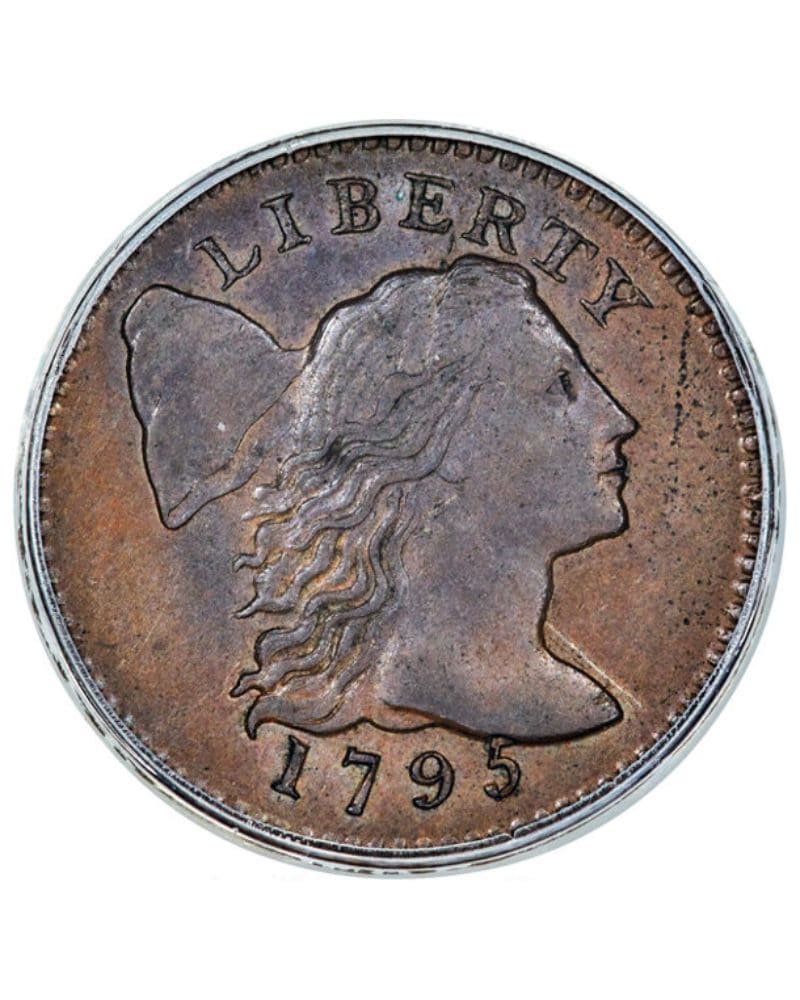
Instead, they were minted by a man named John Harper in an attempt to secure a contract with the government to produce coins. This specific variety with the words “ONE HUNDRED FOR A DOLLAR” printed along the coin’s edge is extremely valuable.
1857 Flying Eagle Cent – $1,027 (Uncirculated Mint State) – $9,669+ (Proof Coins)
The 1857 Flying Eagle coin is especially valuable because it marks a change in American currency. By 1856, plans to discard the larger and more expensive-to-produce Large Cent had begun. By 1857, the U.S. Mint was producing a new and smaller cent featuring a soaring eagle.
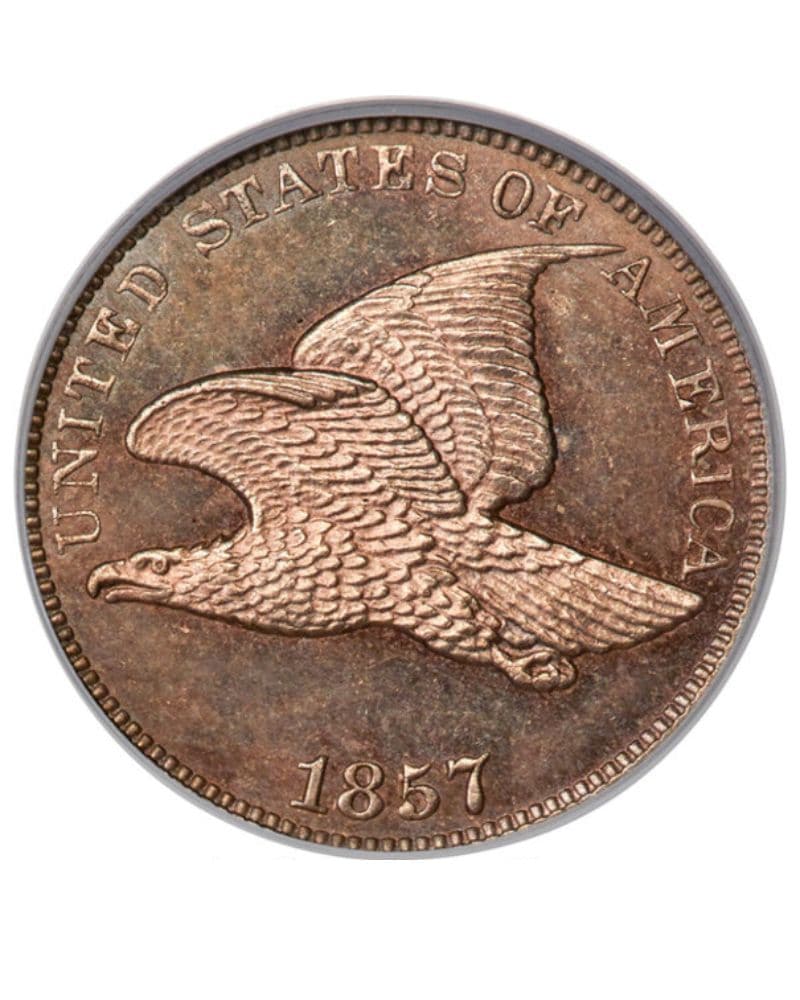
This also marked the beginning of mass production of coins with more than 17 million coins being minted that year. Proof coins, or early samples of Flying Eagle coins, can fetch in the tens of thousands.
1999 Lincoln Memorial Cent (Wide AM) – $558+ (Uncirculated Mint State)
While many of the coins on this list are valued in the thousands or even millions, we felt the need to include this special penny because of how new it is.
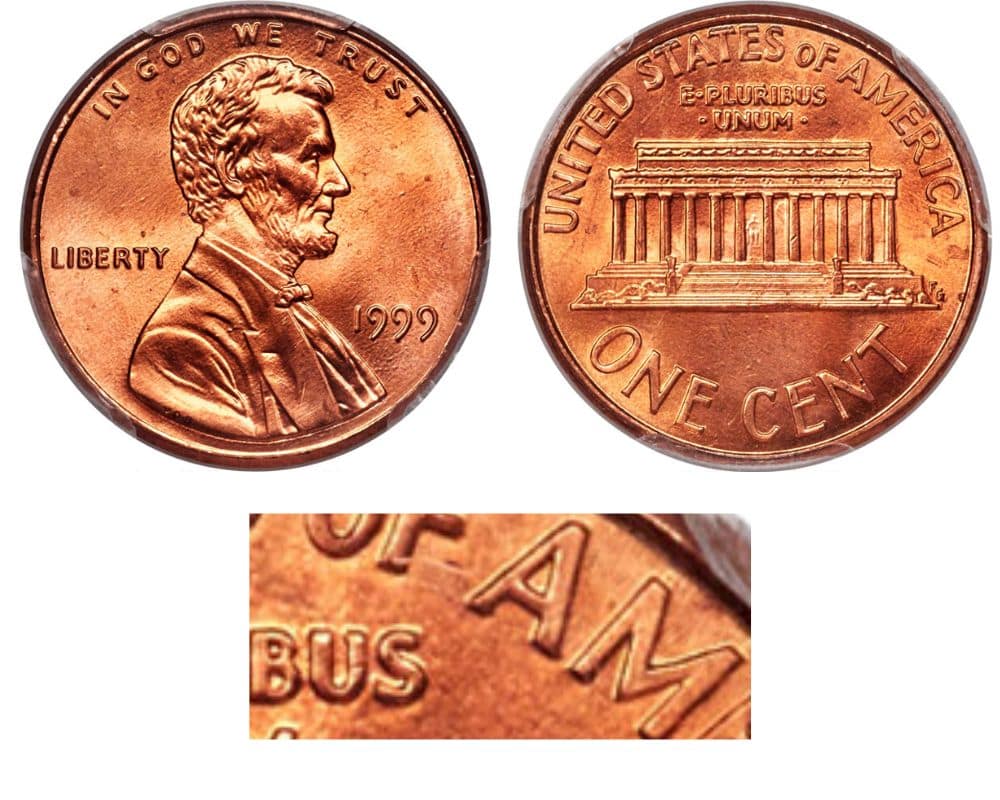
The chances of coming across a penny of 1999 are particularly high, meaning you may just have a valuable penny wedged between the cushions of your sofa! What makes this variety of Lincoln Memorial Cent so unique is the wide gap between the letters “A” and “M” of America.
1907 Saint-Gaudens Double Eagle – $7.6 million
The Saint-Gaudens double edge can easily be considered one of the most beautiful coins ever produced by the United States. President Roosevelt had appointed renowned sculptor Augustus Saint-Gaudens for the designing of a new $29 gold coin with a view to reviving the coinage system of the U.S, which had become a stale topic back in the days.
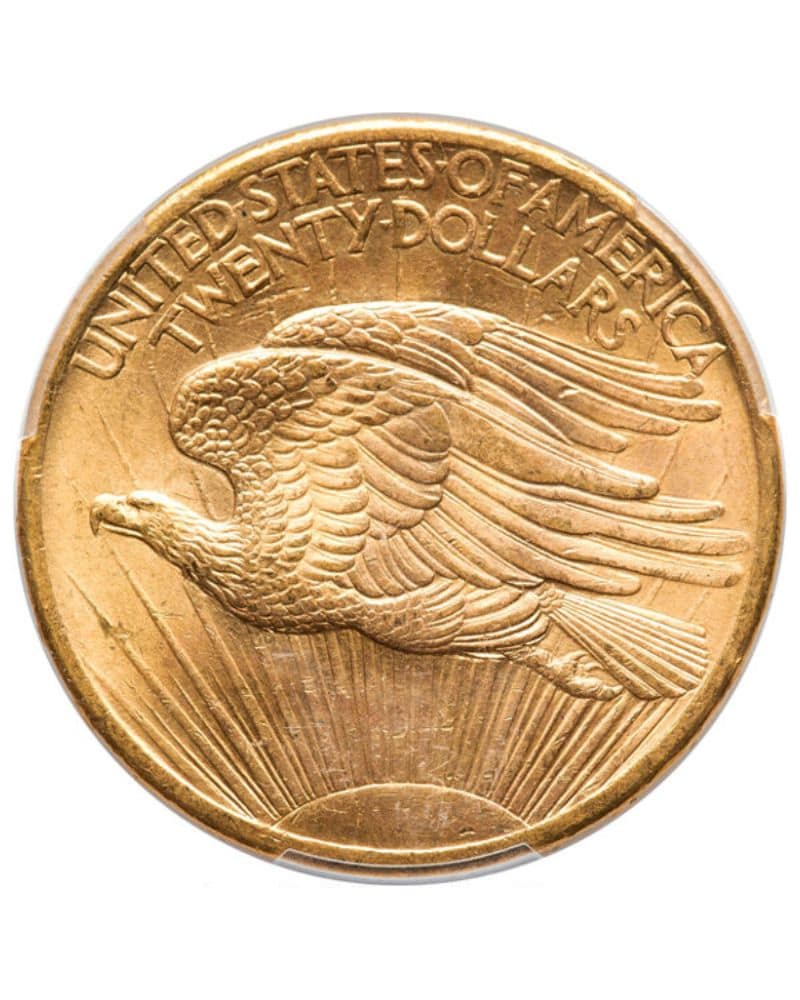
The coin was mainly minted in a high-relief design. This became a problem after the coin expired, so the relief was reduced to ease production.
1943-S Lincoln Cent – $282,000
This 3.11-gram bronze penny is another good example of coin errors. It was mistakenly struck on bronze instead of a zinc-plated steel planchet. It is supposed that only half a dozen or even fewer of these coins have survived to date.

One of those six coins, minted in San Francisco, was certified as the second finest 1943-S bronze cent. It was sold in California in February 2016 and was worth $282,000.
1958 Doubled Die Obverse Lincoln Penny – $336,000
This bronze coin weighs 3.11 grams. The double image on it is the result of damaged dies or minting errors. This belongs to a rare type, and it is believed that only three of its kind has survived to date.
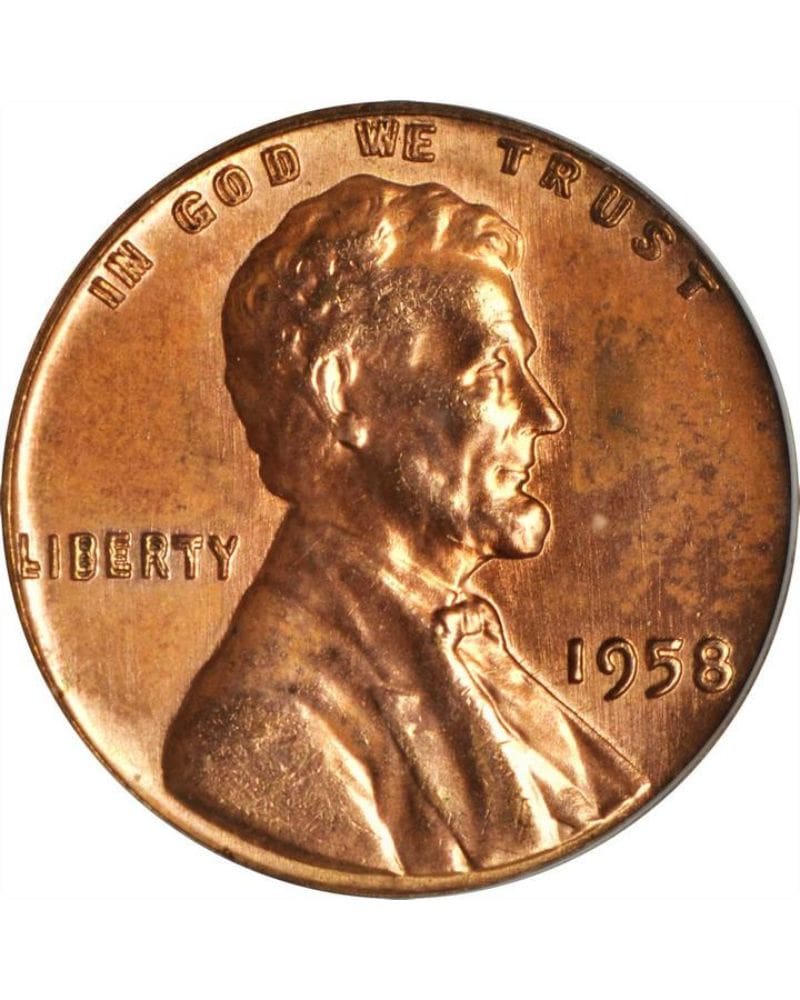
The coin is made from copper, tin, and zinc. The red color has added extra value to it. In March 2018, it was sold for $336,000 at Stacks Bowers Galleries Auction at the Baltimore Coin Show.
1794/5 Flowing Hair Silver/Copper Dollar – $10 million
That much for a coin? Is that even possible? Yes. The 1794/5 Flowing Hair Silver Dollar was sold at an auction in January, 2013 for a whopping $10 million.
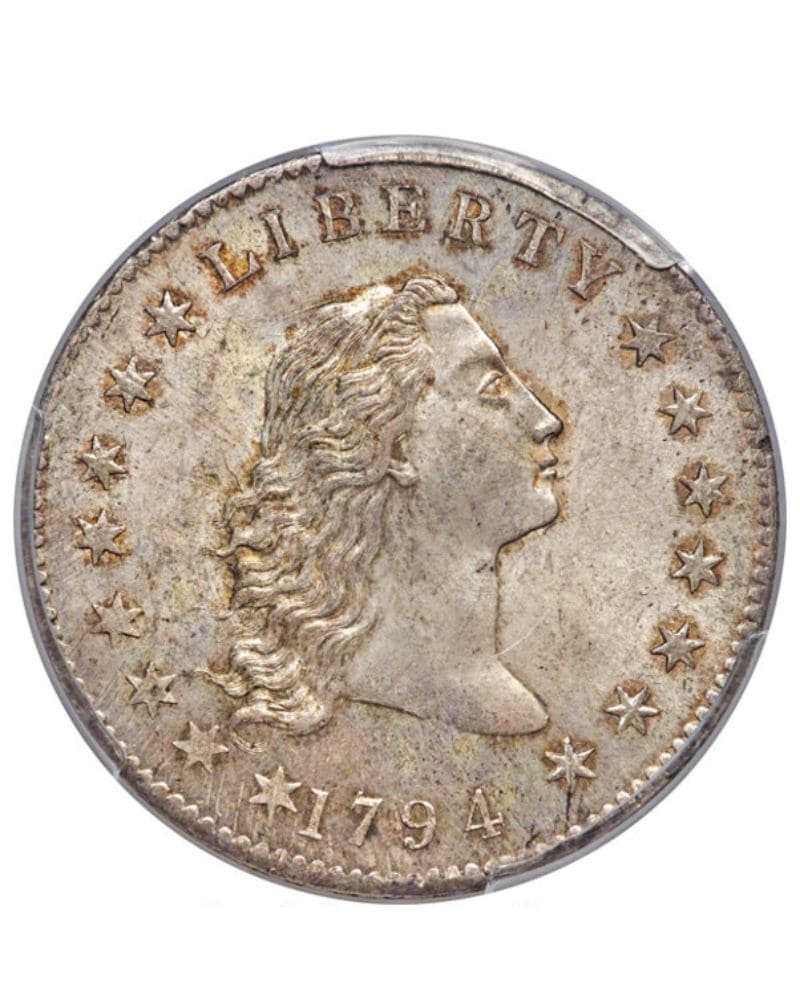
It was the first dollar issued by the United States government in coin form and was minted for only a year. The buyers expressed great pride after bagging the prized coin as it has a significant role to play in the numismatic history of the U.S.
1944-S Lincoln Steel Penny – $373,750
These coins were also going to be minted in a bronze alloy having 95% copper, the rest being tin. Surprisingly, all three mints were used on zinc-plated steel planchets by mistake. This mint error ended up becoming the reason why these coins are now considered unique and rare.

An uncirculated penny was sold in Baltimore. This zinc-coated steel coin weighs only 2.70 grams but made $373,750 for Heritage Auctions in August 2008.
1787 Brasher Doubloon – $7.4 million
The 1787 Brasher Doubloon symbolizes one of the biggest moments of American numismatic history. This was the first gold coin the U.S minted. The most expensive one features the Brasher hallmark initials that were indented onto the breast of the eagle; the first and last of its kind.
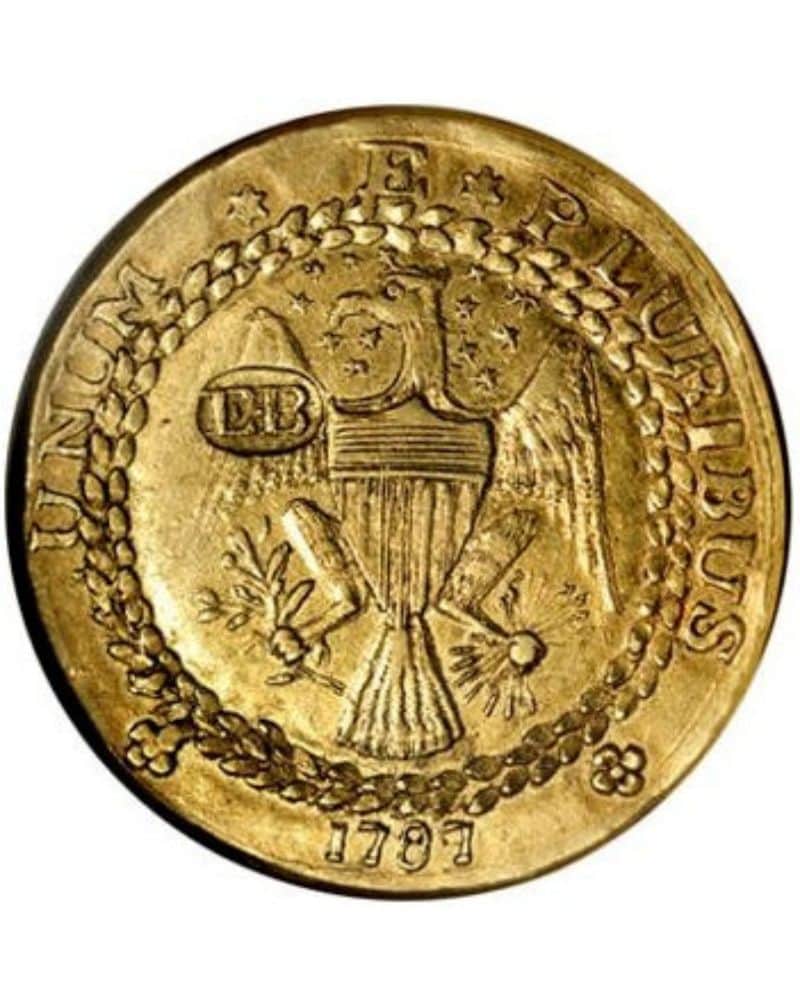
It’s composed of 89% gold, 6% silver, 9% copper, and the remaining are a blend of other elements. Recently, it was placed back on the market.